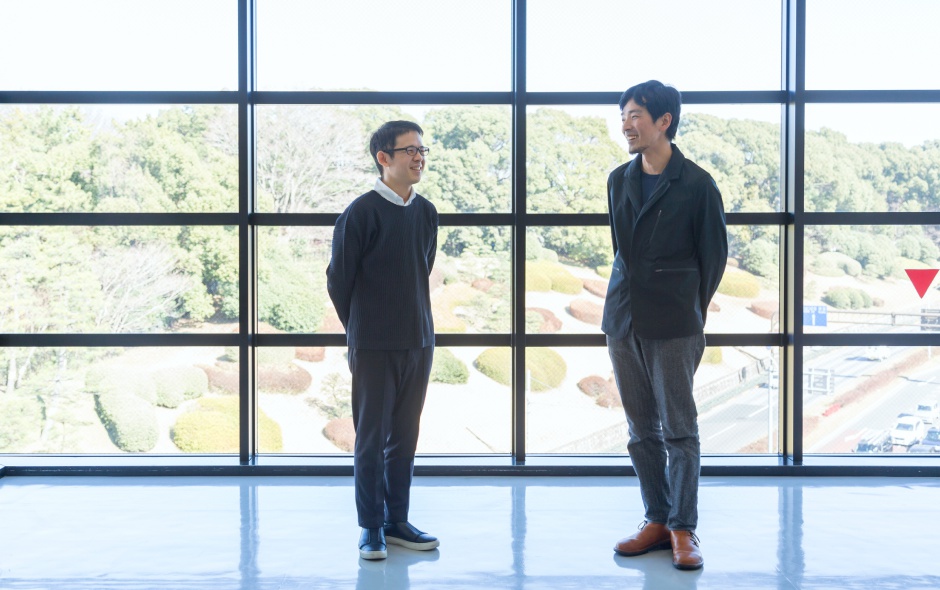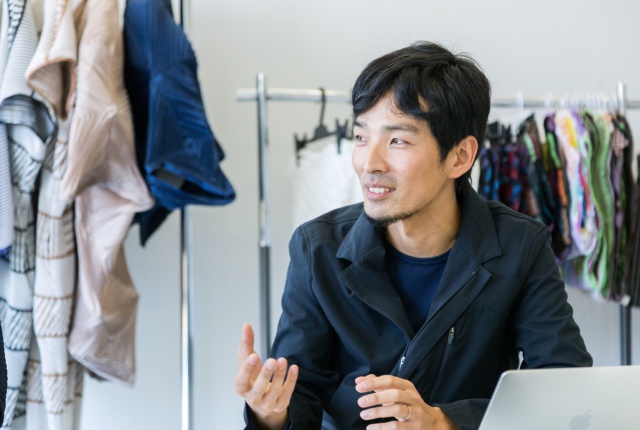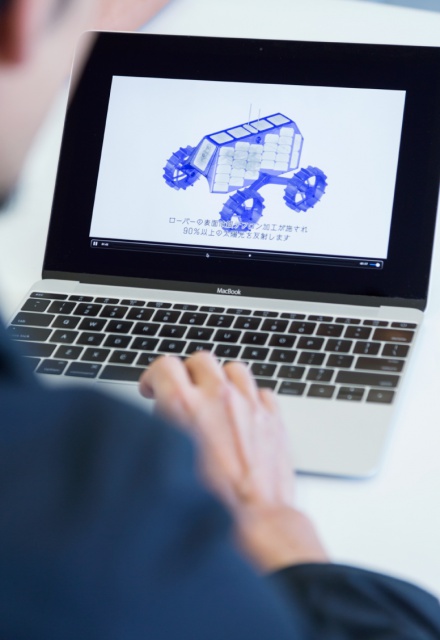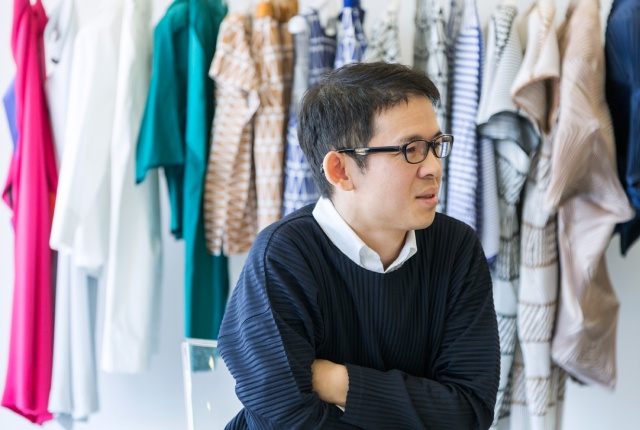vol.
016
MARCH
2017
vol.016 / Roundtable
The expanding scope of our physical sensations
Yoshiyuki Miyamae (Designer) × Hisato Ogata (Design Engineer)

Yoshiyuki Miyamae is in his sixth year as a designer at ISSEY MIYAKE.
Hisato Ogata brings together perspectives from design and engineering in a range of projects. Although they work in different fields, the two men intersect on a deep level in their way of thinking.
As technology develops, possibilities in the world of design are expanding. Some of those possibilities lie in the field of design engineering. Miyamae and Ogata began their conversation by discussing just what role that field can play.
Miyamae: Ever since I was a child I wanted to be part of the fashion world. I loved the color and shape of clothes, and the brilliant presence they took on when people wore them. I wanted to go down that path in the future, so I studied fashion design at Bunka Fashion College. That was just at the turning point when we were about to enter the 21st century. I was very interested in the question of what kind of fashion would change the world in the coming era. For me at that stage, the concept of ISSEY MIYAKE’s A-POC (A Piece Of Cloth) project came as a total shock. That was actually when I became familiar with the term and concept of engineering.
Ogata: I know what you mean. People typically think of design as dealing with visible form and color, or texture and pattern, which I’d say is close to styling. However properly speaking, design ought to include plans for how to achieve those things, which is to say, it should include engineering. In that sense, ISSEY MIYAKE’s clothes gave the impression of having been very carefully thought out and constructed, starting with a design for how people’s bodies would relate to the clothing. They probe the essence of design.

Miyamae: Issey Miyake and Dai Fujiwara launched the A-POC project in 1997 based on an idea that in the coming era engineering would become even more important than color or form. At the time, Fujiwara was calling himself a design engineering director rather than a designer. The A-POC project developed a method for using computer technology to create clothing from a single thread using one-piece patterns. It was truly an attempt to pursue new relationships between the body and clothing from an engineering perspective. The cloth produced using this method could simply be cut out along pre-marked lines with scissors and it would be ready to wear. At the time, I had been leaning towards seeing fashion design as equivalent to styling, and so this concept turned my existing values upside down. It was a shock in the best sense of the word.
Ogata: And after you had that experience, you got a job at MIYAKE DESIGN STUDIO?
Miyamae: Right. After I was hired, I studied A-POC under Miyake and Fujiwara. That was when I fully realized the importance of design engineering. Of course our job wasn’t to make these stiff products dominated by the engineering side of things. It was ultimately to deliver designs that incorporated the zeitgeist of the day and lifted the spirits of the people who wore them. In the end, with clothing, design and engineering became two elements that could never be separated from one another.
Ogata: Listening to you say that reminds me of a debate several years ago among the members of takram about what our identity was. Right around that time, we were talking about publishing a book on takram (takram design engineering | design innovation no furiko [Takram Design Engineering: The Pendulum of Design Innovation], LIXIL Publishing, 2014) and so we were rethinking these questions. The answer we arrived at was that our strength lay in moving back and forth very quickly between seeing things as designers and seeing them as engineers. For instance, some problems that seemed very hard to overcome if we approached them as designers were surprisingly simple to overcome from an engineering perspective. The image of a pendulum swinging dramatically back and forth fit takram nicely.

Miyamae: I would love to be able to do that myself.
Ogata: Incidentally, people tend to think that as you swing back and forth between design and engineering they meld together, but my sense is it’s more accurate to say that each has clear boundaries and you’re swinging between them. It feels similar to running into a dead end when you’re trying to solve a problem using your brain and deciding to try using your hands or body, and suddenly a path opens up in front of you. I feel like it’s also similar to the relationship between questions and problems. Every day at work I’m asking questions and searching for answers, but sometimes I can’t find an answer. At those times I go back and change the original question. And when I do, I find an answer. I feel like I’m constantly moving back and forth between design and engineering, and between questions and answers.
Miyamae: I completely get what you’re saying. At its core design is also a process of posing questions. Miyake often says that once you lose your awareness of problems you’re finished as a designer. My main role on the ISSEY MIYAKE team is to throw problems at everyone else. What about you? The public perception of takram is that people can bring just about any problem to you guys and you’ll solve it.

Ogata: I think there are definitely problems we can’t solve, but it’s true that recently we seem to be getting an increasing number of abstract requests. We do resolve practical problems such as how to improve a certain user interface, but we also do a lot of jobs that start by revising the very problems the client is trying to address. And then we also get inquiries like, “We’ve developed this thing, can you find a use for it?” which come before the problem has even been established.
Miyamae: You sound like a family doctor. (Laughs)



